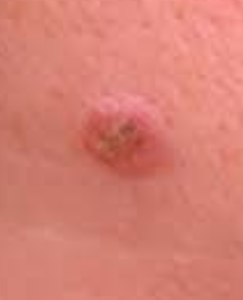The pre-malignant moles are usually removed via freezing or cryosurgery. As per the kind of precancerous moles present on the body, other treatment options include electrical currents, surgical excision, or laser surgery. Sometimes, physicians may do a biopsy of the moles. In case, doctors are sure that the moles will eventually turn cancerous, then they may opt for radiation therapy or chemotherapy.
The precancerous moles are usually treated via cryotherapy, wherein the lesions are surgical removed by freezing them with liquid nitrogen it is a quick, easy, and efficient treatment that causes minimal scarring and pain.
Types of precancerous moles
A few common types of precancerous moles along with their symptoms and treatment options are mentioned below:
- Actinic keratosis: It is the most common type of precancerous lesions or moles. Actinic keratosis usually affects those parts of the skin that are damaged due to exposure to sun. These moles or lesions are flesh colored or reddish scaly patches on the skin and look somewhat like warts. The surface of these lesions may be dry and rough to touch. The bump may not be noticed till the scales are felt/touched by a person.Since actinic keratosis occurs on sun-affected and sun-damaged skin areas, they are common found on the ears, face, upper back, arms, upper chest, and the scalp.
- The moles are regarded as precancerous because a small percentage, i.e., around 5 percent, of such skin abnormalities turn into squamous cell carcinoma if left untreated. Squamous cell carcinoma can be an extremely invasive form of skin cancer.It may also be noted that all squamous cell carcinomas do not necessarily form from actinic keratosis lesions.
- The duration taken by actinic keratosis precancerous moles to develop into squamous cell carcinomas is variable, but it is necessary to treat all and every case of actinic keratosis.
- Patients with many actinic keratosis lesions may need chemical treatment with special creams, such as imiquimod and/or 5-fluorouracil. The creams caused inflammation and extreme redness of the affected skin area during the initial stages of treatment; these symptoms gradually fade after treatment. Chemical cream therapy lasts from 1 to 3 months. Regular monitoring of the precancerous moles is necessary so as to check for any progression into malignancy.
- Atypical mole/dysplastic nevus: Atypical precancerous moles are unusual and different from normal, benign, harmless moles. They have a higher chance than ordinary moles of developing into malignant melanoma.All such precancerous moles are not similar; some may be more anomalous than others, meaning some may appear to be more malignant than others when observed under a microscope.
- The moles are black, brown, or reddish-brown in color and feature irregular or asymmetrical borders.The moles may have a bumpy surface that is raised in the center, measure over 6 mm diametrically, and be irregularly shaped. They can develop on both non-exposed and sun-exposed areas of the skin, including the buttocks, scalp, back, breasts, and chest.
- As atypical moles carry the risk of developing into melanoma, any and all lesions that change color or shape need to be checked by a doctor for progression into cancer. Greater is the number of precancerous moles, higher are the chances of one of such moles progressing into cancer. Treatment involves surgical excision of the lesions along with some section of the normal surrounding skin so as to make sure that it is completely removed. Doctors may also opt for other treatments as the moles tend to different from one another.
- Cutaneous horns: These kinds of precancerous moles are growths that project outwards from the skin and look like a horn. The lesions are most prevalent in people with fair skin and the elderly. Cutaneous horns also carry a higher risk of developing into skin cancer.
- Congenital melanocytic nevi: They are big moles or birthmarks that may be congenital or form during the early stages of childhood. These precancerous moles have a higher risk of turning into melanoma. The causes and risk factors of congenital melanocytic nevi are not known, but doctors believe that some cell mutation may be the cause.
- The growths may occur as a single mole or they may form in groups of 2 or more. They are black or brown in color, or may feature speckled, multiple colors. Other characteristics include elevated appearance; irregular surface and shape; occurrence of dark, rough hair; and regular or asymmetrical borders.
- Treatment is dependent on the location, size, age of the patient, and potential of the mole to becoming cancerous.
- Small and medium sized moles are monitored with baseline photography and regular checkups; they may be surgically removed for cosmetic purposes.
- Large moles measure over 20 cm. They carry a high risk to becoming melanoma and hence surgically removed at the earliest, with checkups after every 6 to 12 months. Some precancerous moles may require many surgeries for complete removal.
- Very large moles that cannot be surgically removed are examined for cancer on an annual basis and relevant treatment is given as and when required.
- Lentigo maligna: This precancerous disorder carries a high risk of developing into lentigo maligna melanoma. It is marked by a spreading tan or brown patch on skin, often with siginificant color variations. The lesions are usually flat, tend to gradually become larger over some years, and may feature freckling and/or mottling.
- The precancerous moles typically affect the neck, back, face, lower legs, back of hands, and other skin areas that have been exposed to the sun for prolonged periods.Treatment of the condition includes surgical excision, imiquimod topical chemotherapy, and/or radiation therapy

